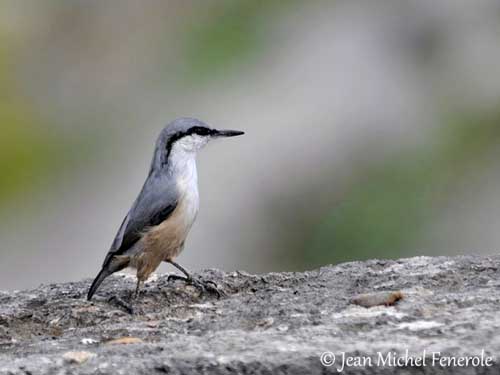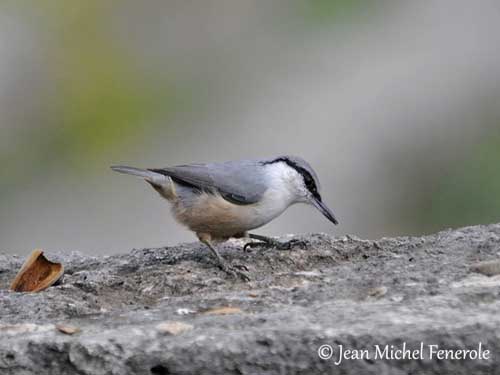
Fr: Sittelle de Neumayer
All : Felsenkleiber
Esp: Trepador Rupestre Occidental
Ital: Picchio muratore di roccia
Nd: Rotsklever
Sd: Klippnötväcka
Photographers:
Jean Michel Fenerole
Photos d’Oiseaux du monde
Steve Garvie
RAINBIRDER Photo galleries
Text by Nicole Bouglouan
Sources:
HANDBOOK OF THE BIRDS OF THE WORLD Vol 13 by Josep del Hoyo-Andrew Elliot-Jordi Sargatal - Lynx Edicions – ISBN: 9788496553453
THE HANDBOOK OF BIRD IDENTIFICATION FOR EUROPE AND THE WESTERN PALEARCTIC by Mark Beaman, Steve Madge - C.Helm - ISBN: 0713639601
BIRDS OF THE MIDDLE EAST by R.F. Porter, S. Christensen, P Schiermacker-Ansen C.Helm - ISBN: 0713670169
ENCYCLOPEDIE DES OISEAUX DE FRANCE ET D’EUROPE – de Peter Hayman et Rob Hume - Flammarion – ISBN : 2082009920
LES OISEAUX D’EUROPE ET D’AFRIQUE DU NORD par Hermann Heinzel, Richard Fitter, John Parslow - Delachaux Niestlé - Isbn : 2603014862
BirdLife International (BirdLife International)
Wikipedia, the free encyclopaedia
Western Rock-Nuthatch
Sitta neumayer
Passeriforme Order – Sittidae family
BIOMETRICS:
Length: 13 cm
Weight: 24-37 g
DESCRIPTION:
The Western Rock-Nuthatch is usually associated with rocky habitats in mountainous areas. This species is slightly smaller than the Eurasian Nuthatch, but it has the typical appearance of Sittidae species.
The adult has pale blue-grey crown, back, rump, tail, wing-coverts and inner flight feathers. The primaries are blackish. The tail is uniformly grey.
On the head, a long, black eye stripe is conspicuous from lores to side of neck base. Cheeks, ear-coverts, neck sides, chin and throat are whitish.
On the underparts, centre of breast and belly are creamy-white. Sides of breast and belly and rest of the underparts are pale cinnamon.
The bill is dark grey to blackish, with pale bluish base of lower mandible. The eyes are dark brown. Legs and feet are greyish.

In worn plumage, the upperparts are greyer. The flight feathers are paler and browner. On the underparts, flanks are paler.
Both sexes are similar.
The juvenile resembles adult but slightly duller. The eye stripe is duller and there is less contrast between breast and belly.
We can find six subspecies which differ mainly in size and colour tones.
S.n. neumayer (here described and displayed) is the largest. It occurs in SE Europe, W Croatia, S Bosnia, Montenegro, S Serbia, Albania, S Macedonia, S Bulgaria and Greece.
S.n. zarudnyi (here displayed too) occurs in E Greece (Lesbos) and W Turkey. This one is smaller and paler than nominate.
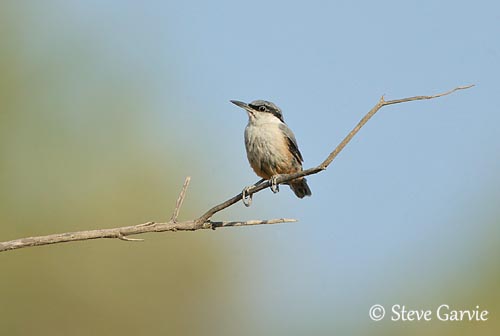
S.n. tschitscherini is found in W and WC Iran in Zagros Mts and mountains S of Qom. This one has much reduced eye stripe, sometimes almost absent.
S.n. syriaca occurs from SE Turkey, NW Syria and extreme N Israel. It is much paler than nominate, with shorter bill.
S.n. rupicola is found from N and NE Turkey, S Georgia, Armenia and SW and NE Azerbaijan, N Iraq and NW and N Iran. This one is darker than syriaca and zanudnyi, with less bluish upperparts than nominate and finer bill.
S.n. plumbea occurs in SC Iran. It is duller and less blue than rupicola, and has pale grey underparts.
VOICE: SOUNDS BY XENO-CANTO
The Western Rock-Nuthatch utters loud, sharp “chik” or “tsik” as contact call, and harsh “charr” or “creea” during aggressive or sexual encounters.
The male sings from perch, rock or small tree, assuming a very upright posture. It gives a loud, rather variable trill, but consisting of loud, clear whistles and trills starting with rapid descending, short “ititit” followed by ascending “toowee toowee toowee…” or descending whistles “chew chew chew”.
In the eastern parts of the range, both mates may engage in duetting in spring and autumn.
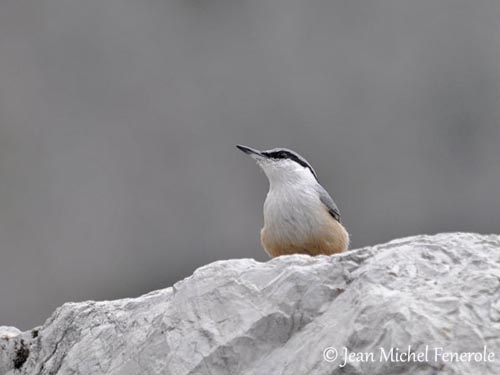
HABITAT:
The Western Rock-Nuthatch frequents rocky areas, bare rocks, rocky slopes, cliffs and gorges, usually in arid regions. It can be found in old buildings, walls and ruins on limestone.
It also frequents areas with low vegetation such as shrubs and grasses, and woodland if there are scattered rocks.
This species is visible from 800 metres to 3300 metres of elevation according to the range.
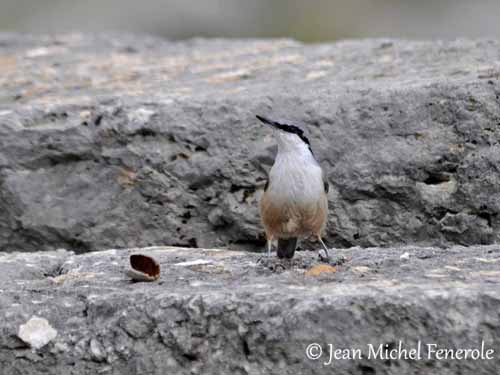
RANGE:
See above in “subspecies”
BEHAVIOUR:
The Western Rock-Nuthatch feeds primarily on insects and spiders in summer. During winter, it takes snails and seeds.
It forages on the ground and on rocks, hopping easily from rock to rock and jumping up crags from where it extracts food items. It may also forage in trees and vegetation, and climbs with agility, progressing with jerky hops.
Like other Sittidae species, it wedges the large preys in crevice and then, it smashes them with the bill. It may store or bury food too. It is often seen alone or in pairs. Both mates feed together and may defend their feeding territory.
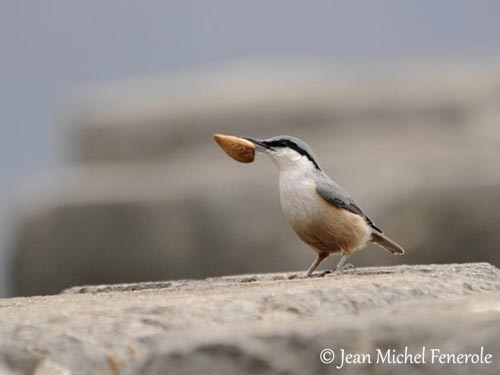
At the beginning of the breeding season, the Western Rock-Nuthatch is seen in wet areas on the ground where it collects mud. This mud will be used to reduce the entrance of the nest hole.
The male builds the nest with the mud which is the main building material. It will need 10-18 days for building the flask-shaped structure. Such nest is made in rock face, often below a rocky ledge. This stunning construction is made mainly with mud, but also animal dung and hair which harden as they dry.
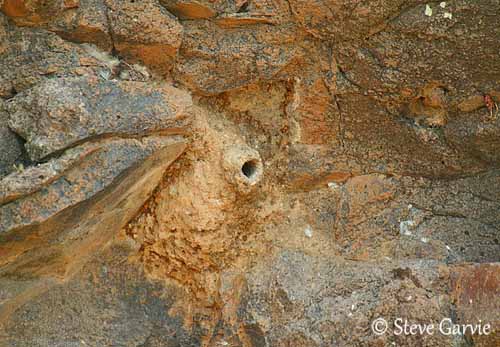
The tunnel entrance is about 10 centimetres long, with a diameter allowing only the movements of the adults. It is placed at two metres above the ground. This nest can be reused for several breeding seasons. It is really secure and melts into the background.
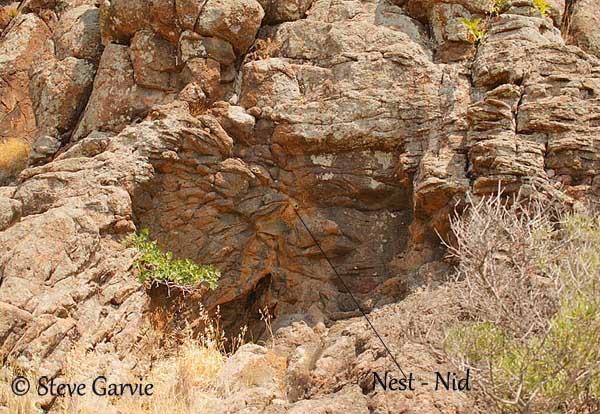
They are territorial during the breeding season. As resident species, the Western Rock-Nuthatch probably maintains the territory all year round. Threat displays with raised and spread wings, bill pointed upwards, half-opened and drooped wings are performed in front of intruders. Some fights between males can be intense.
During the breeding period, the male performs courtship feeding to the female prior to the laying.
The Western Rock-Nuthatch is resident in its range, only performing post-breeding dispersal. Altitudinal movements are reported in winter. They occasionally perform short-distance movements.
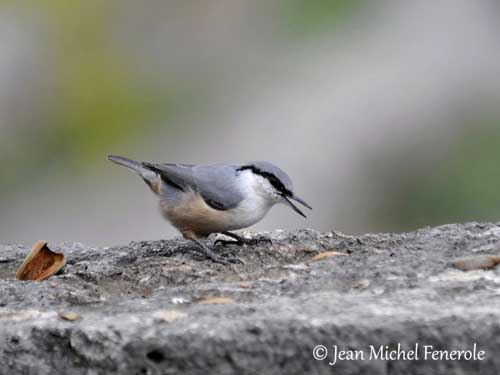
FLIGHT:
The Western Rock-Nuthatch has fairly strong flight, direct over short distances, and more undulating during longer flights.
REPRODUCTION:
The breeding season occurs between late March and April/May, later at higher altitudes, to late May. There is probably a second clutch to early July.
The pair defends the nest-site, at least the close vicinity of the nest. The male builds the nest (see above in “Behaviour”) and the female adds some finer materials for the nest-chamber’s lining, such as hair, wool, feathers and grass.
The area around the nest can be decorated sometimes, with both artificial and natural items. The bird wedges the objects into the adjacent crags and crevices.
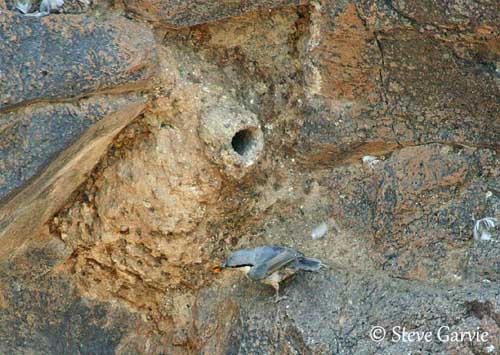
The female lays 4-10 white eggs with sparse brownish markings. She incubates during 13-18 days. The male may feed her on nest during this period. The chicks are fed by both parents, and leave the nest about 23-30 days after hatching.
DIET:
The Western Rock-Nuthatch feeds on numerous insects and spiders during the summer, and feeds its chicks with animal food. During winter, it takes snails and seeds.
They forage in pairs on rocks, on ground, in trees and vegetation.
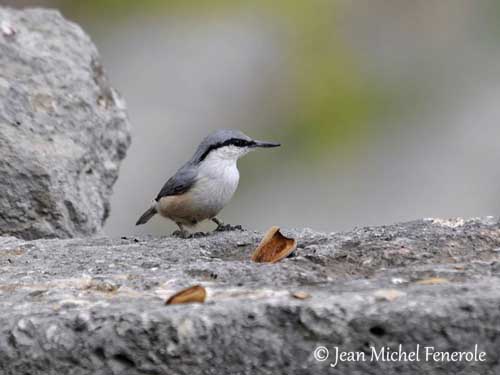
PROTECTION / THREATS / STATUS:
The Western Rock-Nuthatch is common but local throughout its range. Populations appear stable, and this species is not endangered.
